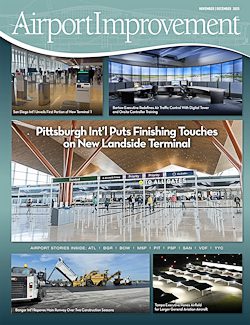This rebrand scales a proven model from Dubai to Lima, converting underutilized terminal space into revenue-generating inventory.
London, 29th October – Airport Dimensions has rebranded its sleep product as Sleepover, formalizing a new airport sleep station category. It is a bold evolution of the former sleep ’n fly concept and a direct response to the changing needs of modern travelers. Sleepover gives travelers privacy and real rest in the terminal while helping airports activate space that is often underutilized. The product is proven at Dubai International and Hamad International Airport in Doha, and at Lima’s recently opened Jorge Chávez International Airport, where early usage is showing strong traction, with high demand, particularly for Flexisuites and Nap Pods, with guests typically staying three to four hours on average. Sleepover offers a quiet, book-by-the-hour refuge in a range of formats so passengers arrive rested for the next leg of their journey.
Sleepover’s proposition is deliberately simple: modular pods and cabins that feel calm, safe, and comfortable, with optional add-ons such as showers. For passengers, it replaces improvised naps or the need to leave the airport in search of alternatives with genuine rest and a sense of control over their journey. For airports, it provides a flexible way to respond to overnight waves, long-haul connections, and irregular operations, deploying formats to meet their space and demand requirements. Insight from Airport Dimensions’ recent AX25 and Experience Era global research further underscores the demand for sleep stations: 49% of passengers say they actively want or are highly interested in sleep facilities at airports, while 95% of airport executives admit current terminal space is not being fully utilized.
Andrew Van Eeden, Vice President, Global New Product & Innovations, Airport Dimensions, said:
“Travelers want privacy and real rest in the hours between or before flights, without having to compromise. Sleepover gives them that calm – in the terminal, on their terms – while giving airports a configurable, insight-led product that fits operational reality.”
Marinela Beke, Travel Retail Manager, Lima Airport, added:
“We saw the gap between the public concourse and premium spaces, especially around early flights and long connections. Sleepover closes that gap with a pragmatic approach. Early adoption has been strong, feedback is positive, and it complements our existing offer by giving passengers a practical way to travel more comfortably.”
Airport feedback shows the model delivers both for guests and airports. Sleepover sits alongside lounges as part of a broader shift toward experiences designed around how people are traveling, not only where they are going. By offering a private, pay-as-you-go option, it complements lounges rather than competing with them, meeting a different moment in the journey with a purpose-built solution. The Sleepover identity is crafted to stand out in busy terminals yet remain easy to read across cultures and languages, supporting wayfinding and rapid recognition for first-time users and frequent flyers alike.
Lauren Burrill, Vice President, Global Marketing, Airport Dimensions, said:
“Sleepover is a brand based on deep listening of guest feedback and consumer insight into what people need to feel at ease. Our role is to turn that understanding into experiences that are simple, intuitive, and scalable. This brand was designed to be instantly recognizable in busy terminals, to work across cultures and languages, and to make the start of any journey feel more human.”
For Airport Dimensions, the launch of Sleepover is a strategic evolution and a clear reflection of the ambition to reimagine what is possible within the airport space. By leveraging their industry-leading depth of insight into passenger needs, Airport Dimensions continues to design solutions that respond to today’s traveler while anticipating tomorrow’s expectations.
About Airport Dimensions
Airport Dimensions believes that journeys should be better for the traveler and more profitable to the airport. That’s why the company continuously seeks ways to open new aspects of customer engagement – using a mix of enriching physical experiences and innovative digital services. Airport Dimensions aims to improve the traveler experience at each turn – from comfortable lounges to restful sleep pods, and convenient food ordering to contactless collection of duty free – all while helping airports maximize non-aeronautical revenue opportunities, retain airlines, and become more competitive.
Airport Dimensions operates 87 airport lounges and experiences, including those in development, located across North America, South America, Asia Pacific, the United Kingdom and the Middle East.
Across the network, Airport Dimensions partners with over 50 airports and multiple airline partners to deliver award-winning hospitality experiences to millions of travelers. Most recently, Kyra Lounge was voted Asia Pacific Lounge of the Year 2025 by Priority Pass members, The Club SFO named Best New Passenger Experience 2025 by ACI, Best Lounge Experience 2025 by Airport Experience News, and Best Independent Lounge 2024 by Business Traveler. Club Aspire at LHR was recognized as the World’s Leading Airport Lounge 2024 at the World Travel Awards, while the Chase Sapphire Lounge by The Club at LGA received a Gold award for Overall Airport Lounge at the Travel Weekly Magellan Awards 2024.
Airport Dimensions is a Collinson company.
About Lima Airport
Lima Airport Partners (LAP) is the private operator of Jorge Chávez International Airport. The partner structure is as follows: Fraport AG, which operates Frankfurt Airport and around 30 major airports worldwide, with an 80.01% stake; and the International Finance Corporation, part of the World Bank, the largest international private sector development institution, with a 19.99% stake. The New Jorge Chávez International Airport is a modern, world-class infrastructure, three times bigger, with a total area of 935 hectares, equivalent to the district of Miraflores. LAP has invested US$2,000 million and, additionally, has received a third-party investment of US$400 million. Over the course of the concession, US$3.635 million have been transferred to the Peruvian State in transfers under the Concession Agreement and taxes over the past 24 years. It is the second-largest infrastructure project in the country, designed to serve up to 40 million passengers annually and consolidate Peru as a strategic air hub in the region.


